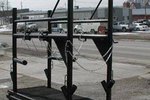Like other equines, miniature horses are well-served by barns with stalls that allow them to see their pasture or paddock. Though many aspects of care for miniature horses are the same as for their larger cousins, special planning must be taken in the construction of their barns -- regular-size horse barns are just too big.
Size Difference
In planning the barn for your miniature horse, size does matter. Full-size horse barns are large and well-ventilated, and they allow a horse to see her pasture. A miniature horse in a full-size horse enclosure may in fact receive too much ventilation, such that they get cold too easily, and would certainly not be able to see over the same doors and gaps that horses can see over. A healthy and happy miniature horse requires much less space than a regular horse.
Dimensions of Stalls and Barn
Opinions differ, but approximately 8 by 8 feet to 10 by 10 feet is substantial enough for a miniature horse to move around comfortably but not too large to make them susceptible to drafts and cold in their individual stalls. The full height of a normal horse barn is also not required -- 6 feet is a sufficient height. The horse will be comfortable, and you will have room to get in and clean it out.
For more than one horse, simply add an additional 8 to 10 feet to one of the sides, though stallions should not be kept directly next to mares once they're sexually mature, as they may attempt to interact through the barrier separating them. If you're going to close the stall in, use a door that's only as high as the horse's withers so that she can see out.
Constructing the Barn
Other than their smaller space requirements, miniature horses are relatively easy to build barns for. There are no steadfast rules for materials or construction methodology, other than making absolutely sure that the barn is a stable structure. Miniature horses are still heavy animals who can run into things accidentally or even intentionally, testing the limits of their surroundings. A solid, concrete block foundation with floors that are elevated off the dirt and with sturdy wooden supports for walls and roofing are your best bet. If you wish to build the structure completely out of wood, sink the support posts feet at least 2 deep, and make sure the barn isn't in the path of drainage or rain runoff.
Step 1: Construct the Floor
Build a sturdy, level floor with 2-by-6 floor joists nailed 2-by-8 mudsills on top of concrete blocks that have been sunk into the ground and leveled, then complete the floor supports with 2-by-6 floor joists spaced every 16 inches. Use at least 3/4-inch thick plywood to create a sturdy, solid floor on top of these.
Step 2: Build the Walls
Use 2-by-4 wall supports, 4 to 6 feet high, also spaced at 16 inches, and secure these to the floor. The same 3/4-inch plywood can be used for siding, or you can use slightly thinner 5/8-inch plywood. You can either leave space for stall doors in the front wall, or you can leave the entire front of the design open, and add gates later, especially in warmer climates. Ventilation is very important, so leave slots for windows and frame these with appropriate wall joists.
Step 3: Put Up a Sloped Roof
Create a sloped roof that encourages rainwater drainage by building roof trusses or by building the front wall higher than the back and using slanted roof supports. Use half-inch plywood to complete the roof, and cover with roofing felt and shingles.
Step 4: Add Gates, Decorations and Accessories
Finally, add appropriate-height stall doors or horse gates, making sure there are no spaces in which a hoof or head may get caught -- avoid cattle gates -- and add any decorative elements that you choose, such as painted exterior siding. In small operations, it is possible to feed the horse in a separate location, though feedboxes placed at one-half to two-thirds of wither height inside the barn against the back wall may also be used for convenience. Place a water source inside the barn.



